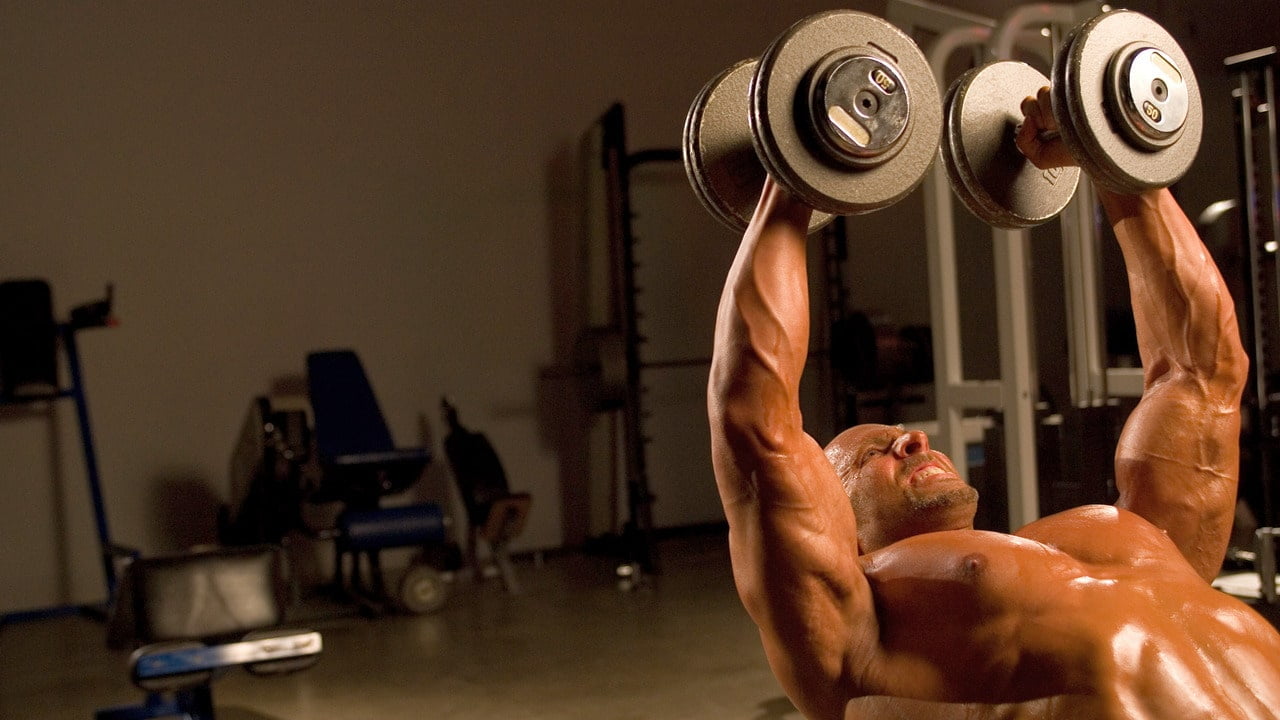
All bodybuilders love to train chest. In fact, in just about every gym on earth, Monday is known as International Chest Day. This is simply because most lifters begin their training week right after the weekend and everyone just loves to pump up the pecs.
However, simply enjoying training chest does not mean you are making any meaningful progress towards building it. And while there are some gym-rats out there that thrive on a regular menu of basic movements like the bench press, incline press, DB flye and dips, others need to think outside the box to coax the pecs into swelling. If that’s you, here are a few unique movements that may help.
Smith Bench Press to Clavicles (aka the guillotine press)
Lower bar to between the clavicles and Adam’s apple
Set a flat bench inside a Smith Machine. Lie down and grab the bar with a shoulder wide (or a tad wider), overhand grip. Lower the bar under full control to a point between (and an inch above) your clavicle bones and Adam’s apple. Using pec-power, press the bar back up to just before lockout. The elbows should be perpendicular to your torso while both lowering and pressing.
Not only will you get a massive, growth producing stretch, but will also greatly target the upper portion of the chest, which is most often lacking in development.
Smith Reverse Grip Bench Press
Utilize an unerhand, rather than overhand, grip on the bar.
Set a flat bench inside a Smith Machine. Lie down and grab the bar with a shoulder wide (or a tad wider), underhand grip. Set up your torso so that when you lower the bar, it makes contact at about nipple level.
While focusing on the chest, press the bar back to a point just before lockout. Do not tuck the elbows into the body during this movement, but rather allow them to take their natural path.
This exercise has been show in EMG studies to stimulate the upper pecs to an even greater degree than the standard incline press. Thus, if the basics are not getting it done, see if this movement adds some size under your clavicles.
Feet Forward Seated Chest Press Machine
Sit forward on the seat, leaning back onto the back support.
Sit on a Seated Chest Press machine. Slide your rear end forward to the end of the seat and allow your upper body to simply lean back against the back support pad.
Place your feet out in front of you, making sure you are locked in position and fully stablized.
Grab the handles and press the weight until full lockout, making sure to powerfully contract/squeeze the pecs before slowly lowering back to the starting position.
Because of the position of the torso in this movement, you will shift the emphasis (even more so) onto the lower pecs. Now while it is generally easier to build size in this area of the chest, this exercise is awesome for really sculpting and defining that lower-pec line.
Incline Low Cable Upper Pec Flye
Performing standing with back against an incline bench.
Sit an incline bench (set to about 75 degrees) in the middle of an adjustable cable crossover station. Adjust the cables so that when you grab the handles, your upper arms are at about a 70 degree angle to your torso.
While standing, lie back onto the incline bench, and grasp the handles with the palms in a flye position. With a slight bend in the elbows begin to adduct the arms across and upward so that when the handles meet, they are at approximately nose level.
Hold the contraction for 1-2 seconds, really squeezing and tensing the pecs. Lower slowly and under control until your chest is fully stretched at the start position.
This movement is a hybrid of a low cable crossover and incline cable flye. However, it provides a novel stimulus for the chest (especially the upper section – just below the clavicles), because of the unique plane of motion.
Unilateral Seated Angled Chest Press
Sit sideways in the machine.
Sit sideways in any seated chest press machine. Make sure your torso is positioned so that only the rear deltoid is in contact with the pad, allowing for a full range of motion.
As you begin to push the handle, slightly lean back, which will help you extend to full lockout, and create a very strong contraction in the working pec. Make sure to squeeze the chest hard at the top of the movement at least 1-2 seconds.
Unilateral exercises in and of themselves are excellent for increasing nerve force and fiber firing in the working body part.
The unique positioning of the torso in relation to the pressing angle in this movement allows for an extremely intense contraction and will produce significant soreness where the pec ties into the sternum.
I want to make it clear that it is impossible to “isolate” any one area of the chest, as it will contract as a whole unit during any pec exercise.
However, it is possible to better target different sets of motor unit pools in comlex muscles when specific angles, grips and planes of motion are utilized.